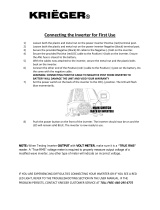
4 PH3300i SM, Rev. 2017-01-20
4.6.1 Fuel Pump Testing ........................................................................................................................... 36
4.7 Engine Speed Cannot Increase or is Hunting ........................................................................................ 37
4.8 Engine Speed Too High .......................................................................................................................... 37
4.9 No or Low AC Output .............................................................................................................................. 38
4.10 Measuring Stator Main Output Voltage While Running ....................................................................... 39
4.11 No DC Output At Battery Charge Receptacle ...................................................................................... 40
4.12 Starting Battery Will Not Charge .......................................................................................................... 40
4.13 Voltage Regulator Testing..................................................................................................................... 41
4.14 Engine Runs-on or Backfires After Being Turned Off ........................................................................... 42
4.15 Engine Will Start Then Shut Down ....................................................................................................... 42
5. REPAIR ........................................................................................................................................................ 43
5.1 Carburetor ............................................................................................................................................... 43
5.1.1 Removal / Installation of Carburetor ................................................................................................ 43
5.1.2 Throttle Control – Step Motor .......................................................................................................... 44
5.1.3 Backfire Prevention Solenoid (BFP) ................................................................................................ 46
5.1.4 Manual Choke Assembly ................................................................................................................. 47
5.1.5 High Altitude Jet ............................................................................................................................... 48
5.2 Control Panel .......................................................................................................................................... 49
5.2.1 Disassembly / Installation ................................................................................................................ 49
5.3 Outer Generator Housing ....................................................................................................................... 50
5.3.1 Disassembly / Installation ................................................................................................................ 50
5.4 Recoil Starter .......................................................................................................................................... 51
5.4.1 Disassembly / Reassembly .............................................................................................................. 51
5.5 Starter motor ........................................................................................................................................... 52
5.5.1 Starter Testing .................................................................................................................................. 52
5.5.2 Starter Removal / Replacement....................................................................................................... 53
5.6 Starter Relay ........................................................................................................................................... 54
5.6.1 Testing Starter Relay on Generator ................................................................................................. 54
5.6.2 Bench Testing the Starter Relay ...................................................................................................... 55
5.7 Intake Fan Cover .................................................................................................................................... 56
5.8 Ignition Coil/Trigger Assembly Adjustment / Replacement .................................................................... 58
5.9 Stator and Rotor ..................................................................................................................................... 59
5.9.1 Stator Inspection .............................................................................................................................. 59
5.9.2 Stator Removal and Reassembly .................................................................................................... 60
5.10 Inverter Inspection / Adjustment / Replacement .................................................................................. 61
5.10.1 Inverter Removal / Preparation for Adjustment.............................................................................. 61
5.10.2 Inverter Adjustment / Replacement ............................................................................................... 62
5.10.3 Inverter Ignition Power ................................................................................................................... 63
5.11 Muffler Removal / Replacement ........................................................................................................... 64
5.12 Engine Exploded View .......................................................................................................................... 65
5.13 Cylinder Head / Valves ......................................................................................................................... 68
5.13.1 Cylinder Head Removal ................................................................................................................. 68
5.13.2 Cylinder Head Disassembly and Reassembly .............................................................................. 69





















